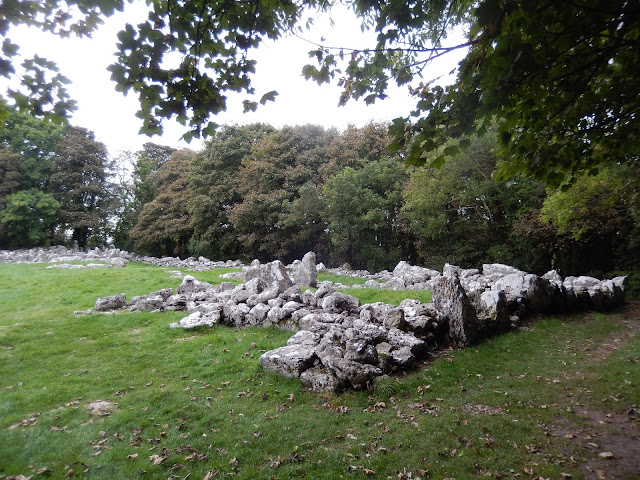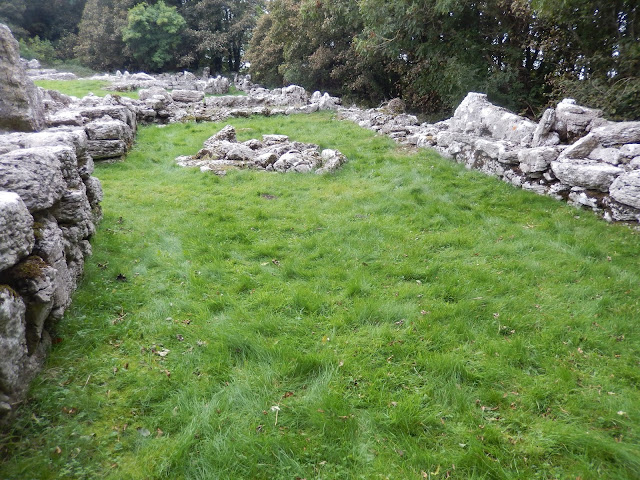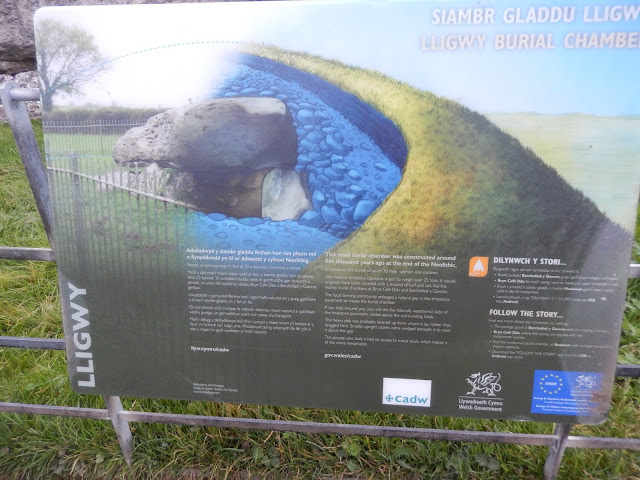Helo Pawb (Everyone)
As hinted at in my last post, my instincts told me to look to the land southwards of Bryn Celli Ddu for the setting of my protagonist’s village. The Explorer Map showed something called Caer Lêb, situated not far from Afon Braint. I decided to check it out.
After locating the site and its parking, I chatted for a few minutes with two men loading a trench digger onto a trailer. I told them I was exploring ancient sites and one of them noted how you could throw a stone anywhere on Anglesey and hit one. He also told me of a nearby farm that had a standing stone and the remains of two stone huts in its fields.
But first, Caer Lêb, which means Leaven Castle. The site is a low-lying enclosure defined by double banks and marshy ditches. Excavations revealed three stone-built circular huts, one of them having a flagged floor and a fireplace.
 |
| Display board at the site |
 |
| View of ditch and embankment |
 |
| View of the enclosure itself |
The official trail signs were a little vague, but I eventually found the remains, in a field in which a herd of Welsh Blacks was grazing. Disappointingly, much of the stone from the huts must have been used for local fences or houses, as there wasn’t much left. After taking a photo of the nearest of the two, I started towards the other one, when the herd moved en mass towards me. Thus began one of the scariest moments of my life as I wondered if they were going to trample me for invading their space.
I edged back to the first stone hut and sat down in the middle, thinking that the rocky terrain would make it difficult for the cattle to maintain their footing if they decided to rush me. For ten minutes or more, I watched them crowd around me, snorting, bellowing, and pushing at each other to get to the front. I talked to them quietly and made sure I didn’t make any sudden movements.
 |
| The first stone hut fragments, with the second one in the distance to the left |
 |
| The herd of Welsh Blacks noticing me |
Eventually, I knew I should try to leave and see what happens. I stood up slowly and gently and strolled as nonchalantly as I could towards the gate. I could feel them following me, but resisted the impulse to see how many were there and what their mood was like. After I made it through the gate, with the whole herd gathered around it, relief flooded me and I was surprised at how calm I had been throughout the whole ordeal. Were they annoyed at me or just inquisitive? I don’t know. Still, the presence of so much horned muscle isn’t something I wish to experience again.
Ten Minutes
 |
| The Welsh Blacks milling around the gate after I went through |
Hemmed in by 20 or more snuffling, bellowing Welsh Blacks
Bullocking each other to sniff my foodless backpack and me,
I sit on the stone hut fragments I had come to explore…
Talk softly. Don’t shake. Wait. Don’t run. Don’t look back.
After my pulse settled down, I wandered the farm tracks until I found the standing stone. Luckily, no Welsh Blacks grazed in that field.
The upshot of this particular location scouting is that I will place my protagonist’s village near the site of the old stone huts, which is close to Afon Braint and only a short distance from Bryn Celli Ddu. I may even use the standing stone, though I’m not sure how as yet. As for Welsh Blacks, even though they are descended from pre-Roman cattle, if I feature any cattle in my story it will likely be the Celtic Shorthorn, which is now extinct.
 |
| Interesting shape, with one side flat and facing north |
 |
| The interesting shape and texture of the stone |
As always, I welcome your comments and I wish you adventurous days, though hopefully not as drama-filled as this one was for me.
Cofion Cynnes (Warm Regards)
Earl

























